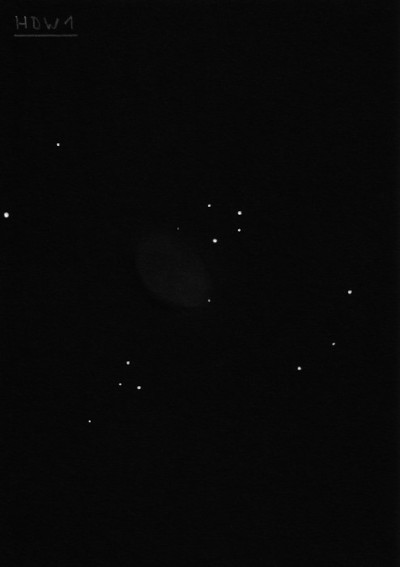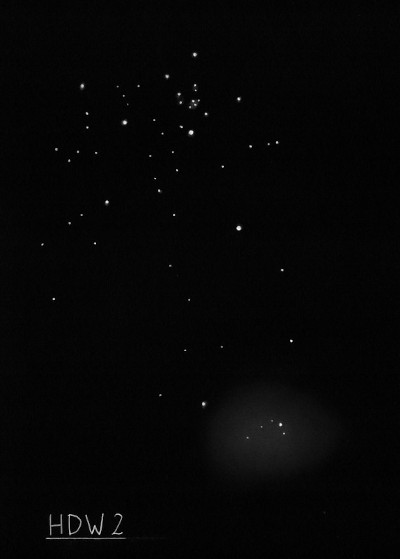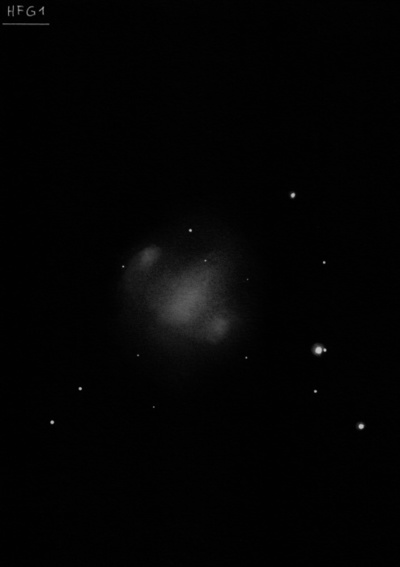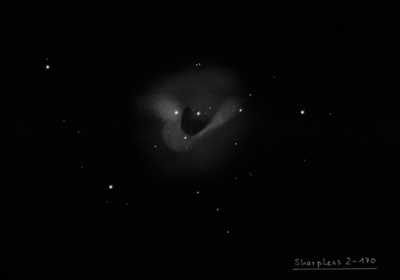A constellation near the North Pole, it is circumpolar in our latitudes. It's one of the constellations we can easily identify in the sky. Five bright stars form a characteristic "W" or "M" shaped constellation in the star-rich Milky Way, on the opposite side of Polaris from the Big Dipper. Cassiopeia is crossed by the autumn Milky Way and the constellation is therefore also extremely rich in open star clusters. Some are among the most beautiful in the sky, while others are only tiny groups or clusters of stars nestled in rich star fields, and are therefore not easy to discover and correctly identify. Without a detailed constellation map, we can quickly get lost in this area. The constellation is also decorated with a few nebulae, a few galaxies and a large number of colourful double and multiple stars.
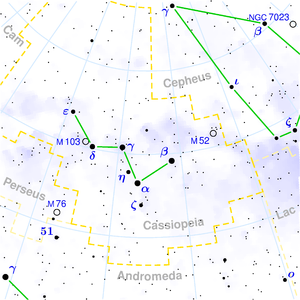
We look into the constellation Cassiopeia and its surroundings in the direction of galactic rotation, but out of our arm. Because there are no large clouds of interstellar material in this region, we can admire the arm of Perseus in our autumn sky. This is the main outer arm, lying furthest from the centre of the galaxy. It's wide, ragged and merges with the Orion arm in places. Rather than encircling the Galaxy in a continuous line, it is a series of disconnected clouds of young stars and nebulae. Seen from a distance, it would appear as a faint arm with many concentrations of young stars and nebulae. Unlike the Sagittarius and Ruler arms, however, it does not have a major effect on the appearance of our Galaxy.
Let's follow the course of the Milky Way in the sky. The main stream continues through Cassiopeia and cuts directly through the five bright stars of the constellation. It is very uneven, tapering off a little and losing a little intensity. It is sharply defined in the northern part, but in the south it passes very smoothly into its surroundings, and in a side view almost touches the Great Nebula in Andromeda during excellent conditions. Its brightest part is a narrow belt stretching from stars 1 and 2 Cas to stars 9 and 10 Cas. This belt is flanked on the south side by a single oval, slightly conspicuous brightening, on the edge of which lies the open cluster M52, which is not the easiest to observe with the naked eye, and is sometimes confused with a small conspicuous brightening in its neighbourhood, which is only a chance grouping of about four faint stars.
A few brighter areas and a few darker areas are still visible in the main stream, the most striking of which is the oval bay penetrating the main pattern of the constellation to the star δ Cas. Conversely, there is a small brightening near γ Cas, and a small hazy circular patch is visible to the naked eye just off the ε Cas star. On closer inspection, the triangle of stars 52, 53 Cas and HR 657 (magnitudes 6.0 - 5.6 - 5.3) can be easily distinguished. In the southern part of the constellation, on the other hand, a large group often referred to as Stock 2 is an ideal object for the binocular. It consists of about 50 stars of 9th and 10th magnitude covering an area of the sky of one degree.
Translated with www.DeepL.com/Translator (free version)
Schedar (α Cassiopeiae) - This orange star, located 228 light years away, is 676 times brighter than our Sun, but it appears only as a 2.23 magnitude star in the sky (the actual magnitude varies by a few tenths).
Cih (γ Cassiopeiae) - The white dwarf, with a star in the middle of the letter "W", is the brightest in this group. It is approximately 34,000 times more luminous than the Sun and located 550 light-years away. Using a larger amateur telescope, we will reveal a companion with a brightness of 11mag at a separation of 2.3".
Achird (η Cassiopeiae) - well-known binary star, discovered in 1779 by William Herschel. The yellow, golden star (3.7mag) has a separation of 13" (with the separation changing from 5" to 16" over the period) and is accompanied by a companion of brightness 7.4mag with a red, purplish tint, which orbits it every 526 years. The binary star can be resolved in a 6 cm telescope.
ι Cas - one of the most beautiful triple stars in the sky. The main, white star with a brightness of 4.7mag is accompanied by a yellow and blue component. At a distance of 2.3", there is the first companion with a brightness of 7mag. At a separation of 7.2", there is a second component associated with this system, with a brightness of 8.4mag. The components of the main AB pair orbit each other every 840 years.
ρ Cas - An irregular variable star, similar to R Coronae Borealis, its brightness varies between 4.1mag and 6.2mag in a cycle that lasts slightly less than one year. Suitable comparison stars are σ (4.9mag) and τ Cas (4.87mag). This exceptionally luminous supergiant is located 3400 light-years away. In the sky, we see it near the star β Cas.
RZ Cassiopeiae - Interesting eclipsing variable star. The period of brightness changes is 1.19 days, but the decrease in brightness from 6.18mag to 7.72mag lasts only two hours, while the brightening then occurs immediately and the star returns to its original magnitude in the next two hours.
CAS A - The remains of a supernova, which likely appeared in the sky several tens of thousands of years ago, so there are no proven records of it. Today, we observe the strongest stellar radio source in the entire sky from this region, south of M52. At the location of the radio object, we can find filamentary nebulae expanding at a velocity of 900 km/s, with their distance estimated at 10,000 light-years.
Tychova hviezda - Supernova 1572, one of the three observed and documented supernovae that erupted in our Galaxy in the distant past. It was named after the Danish astronomer Tycho de Brahe, who observed its explosion on November 11, 1572, and the course of its brightness until it disappeared from the sky (it was also observed by Tadeáš Hájek z Hájku). At that time, he did not know that the star had exploded at a distance of 8,000 light-years. The star shone in close proximity to the northwest of the star κ Cas. At its peak, it reached an apparent magnitude equal to Venus, reaching a maximum brightness of -4.0 mag and was visible even during the day. Then its brightness decreased, but it could still be seen with the naked eye for a period of 16 months. Today, it is once again a star with an apparent brightness of less than 19 mag, with an expanding nebula, a radio and X-ray source of radiation.
R Casiopeiae - Long-period variable star with a magnitude range from 4.7 to 13.5 over 431 days. It is located closer to the border with the constellation of Andromeda.
NGC 457
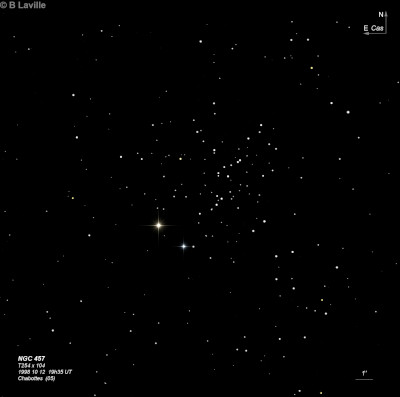
6: striking bird-shape with two prominent "arms". One of my favorite objects in this scope at 36x.
15x50mm (7/26/06): the cluster was slightly resolved in IS binoculars.
William Herschel discovered NGC 457 = H VII-42 = h97 on 18 Oct 1787 (sweep 769) and described "A star [Phi Cass]. About 50 seconds preceding is a cluster of small scattered stars, not very rich." John Herschel recorded "a double star 10m, pos 324.5°, dist 12", in the midst of a p rich L cl which fills the field. The stars are 10m; one of 7 and 1 of 8m in the sf part."
By analyzing William Herschel's early "reviews" of bright stars (before his systematic sweeps), Wolfgang Steinicke recently found (email Oct '16) that Herschel first discovered the cluster on 12 Oct 1782 using his 6.2" reflector.
200/250mm - 8" (1/1/84): ~75 stars in cluster at 100x.
400/500mm - 17.5" (9/19/87): ~150 stars in a beautiful cluster including mag 5 Phi 1 (likely a foreground star) and mag 7 Phi 2 Cassiopeiae. Includes many mag 14-15 stars.
Notes by Steve Gottlieb
IC 1805
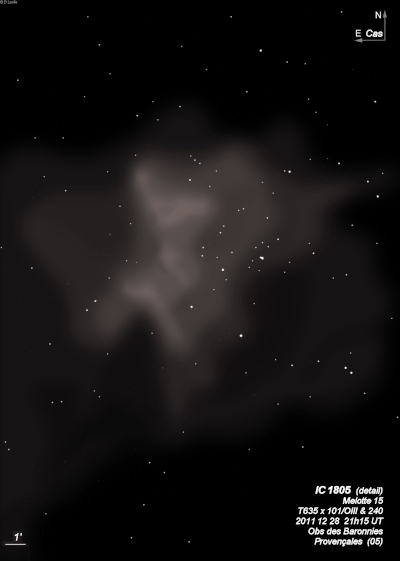
E.E. Barnard discovered IC 1805 photographically with the discovery communicated directly to Dreyer. The NGC position is off by 1 tmin in RA (same as IC 1824 = NGC 1027). Barnard gave a corrected position in his Atlas of the Milky Way.
The Heart (IC 1805) and Soul (IC 1848) nebulae are part of the Cas OB6 Association, a sprawling complex of gas, dust and massive O- and B-class stars at a distance ~7500 light years in the Perseus Arm.
400/500mm - 17.5" (11/27/92): about 125 stars forming a bright, very large 40' field at 100x. In the center is an oval ring consisting of about 30 stars within a 4'-5' diameter including a bright 8th magnitude multiple star (Stein 368). The brighter stars in the outer region form a rough incomplete circular outline. Using 100x with an OIII filter, the associated nebulosity (LBN 654) is clearly entwined within a large portion of the cluster.
Notes by Steve Gottlieb
NGC 281
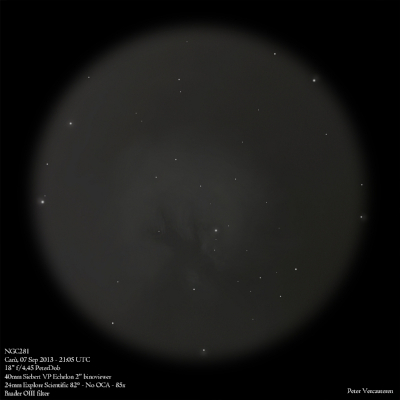
300/350mm - 13.1" (8/24/84): very large, fascinating nebulosity, very irregular, dark gaps between sections, five brighter stars mag 8.6-12.5 involved. The brightest star is a very close double.
400/500mm - 17.5" (9/28/02): the bright central quadruple (ADS 719 = Burnham 1) includes a mag 8.6/9.1/9.8 trio at 4" and 9". At 140x, a fainter companion (mag 10) at 1.54" separation is just visible close following the brightest member and is cleanly resolved at 324x.
17.5" (10/17/98): spectacular view of this detailed HII region at 100x using an OIII filter. This 15' nebulous complex has a mushroom appearance and is separated into three main lobes apparently by dust. The brightest and largest lobe is following a bright triple star embedded near the center (8.6/9.2/9.8 at 4" and 9"). There appears to be a much fainter detached piece off the south end of this lobe. Preceding the triple star is a section that is noticeably elongated and irregular in surface brightness fading to the NW. The section to the north is faintest and separated from the eastern lobe by a curving dark lane. A dark intrusion, apparently due to obscuring dust, is visible south of the triple star.
Notes by Steve Gottlieb
IC 1848
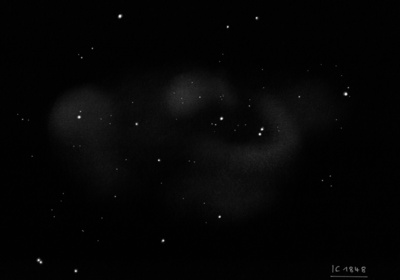
Using a UHC filter at 100x, the field is immersed in a very large, faint nebulosity about a degree in length, elongated E-W. A large, bright region elongated N-S is at the east end, ~35 following the core, and seems detached from the main cloud. It surrounds a weak scattered group (Cr 34) that is devoid of stars in the center. The main body of nebulosity has a sharper border and is generally brighter to the north of the core and fades into the background on the south side. The outline is interesting on the north side with irregular extensions and bulges. A small brighter circular patch stands out at the west end about 10' W of the core.
E.E. Barnard discovered IC 1848 photographically and notified Dreyer directly. The IC description reads "Cl, st F, extends 8 min. f, in F neby." The Heart (IC 1805) and Soul (IC 1848) nebulae are part of the Cas OB6 Association, a sprawling complex of gas, dust and massive O- and B-class stars at a distance ~7500 light years in the Perseus Arm.
400/500mm - 17.5" (10/2/99): at 100x, this large but weak grouping is dominated by a 2' pair of mag 7/8 stars which are both surrounded by several close, faint companions. The surrounding one degree field is undistinguished but it appears weakly concentrated around the bright pair. Faint nebulosity is visible in portions of the field. At 220x, the view is striking with ~12 stars huddled around the southern mag 9 star including a nice pair of mag 12 stars nearly collinear and equally spaced. The brighter mag 7 star (∑306) is surrounded by 8-10 companions. The 20' field is fairly rich but scattered with a matched pair of mag 9 stars ~10' N.
Notes by Steve Gottlieb
NGC 7789
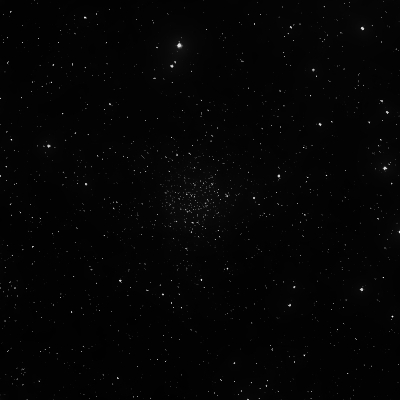
15x50mm (9/6/10): bright but unresolved 15' glow.
15x50mm (7/26/06): moderately bright glow, at least 10' diameter. Observed using IS binoculars.
Caroline Herschel discovered NGC 7789 = H VI-30 = h2284 on 30 Oct 1783 (William had just started his sweeps two nights earlier) with her 4.2-inch reflector, noting "between Sigma and Rho Cass, a fine nebula, very strong." William resolved the cluster with his 6.2-inch reflector on 11 Mar 1784. On 18 Oct 1787 (sweep 769) he called it "a beautiful cluster of very compressed stars, very rich." That evening he swept with a binocular set-up, using two eyepieces. John Herschel called it "a most superb cluster, which fills the field and is full of star; gbM; but no condensation to a nucleus; st 11...18m."
200/250mm - 8" (11/8/80): extremely rich, uniform in faint stars. Certainly among the top open clusters with this aperture.
400/500mm - 17.5" (10/12/85): a few hundred stars were resolved in a 20' field. Remarkably rich and fairly uniform carpet of stars mag 11 and fainter.
Notes by Steve Gottlieb
M 52
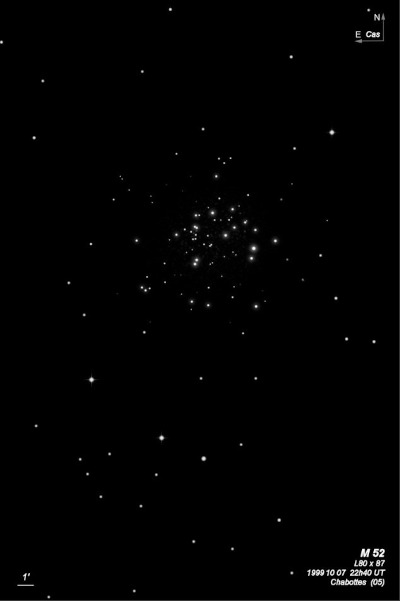
15x50mm binoculars (9/6/10): prominent roundish glow ~10-15' diameter located 40' S of 5th magnitude 4 Cas and on a line with Alpha (Schedir) and Beta (Caph) Cas. A few mag 8-9 stars are resolved.
Charles Messier discovered M52 = NGC 7654 = h2238 on 7 Sept 1774. WH made an early observation on 29 Aug 1783 with his 6-inch and noted, "All resolved into innumerable small [faint] stars without any suspicion of nebulosity." On 3 Nov 1787 (sweep 773), he reported "A very beautiful cl of very compressed stars about 12' dia., nearly R and most compressed in the middle." JH made the single observation, "A ruddy star 9m in the p part of a p rich irreg cl of stars 13m, all separate, 6' diam; a v little more comp in the s f part." Admiral Smyth described M52 as resembling "a bird with outspread wings" and added "the field is one of singular beauty under a moderate magnification."
300/350mm - 13.1" (9/29/84): 150-175 stars in a 15' diameter, a mag 8 star (SAO 20606) is on the WSW edge of the cluster. NGC 7635, the "Bubble Nebula", lies 35' SW.
400/500mm - 17.5" (8/2/86): fills 21' field, fully resolved at 105x.
Notes by Steve Gottlieb
NGC 663
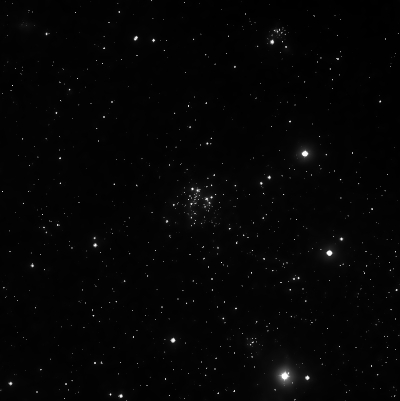
William Herschel discovered NGC 663 = H VI-31 on 3 Nov 1787 (sweep 774) and recorded "a beautiful cluster of pretty large stars near 15' diameter, considerably rich." Neither JH nor LdR's assistants observed the cluster.
300/350mm - 13.1" (10/20/84): ~75 stars, fairly large, rich. Includes several doubles, the most prominent are STF 153 = 9.3/10.3 at 8" and STF 152 = 9.0/11.2 at 9" and STF 151 = 10.5/10.9 at 7".
Notes by Steve Gottlieb
M 103
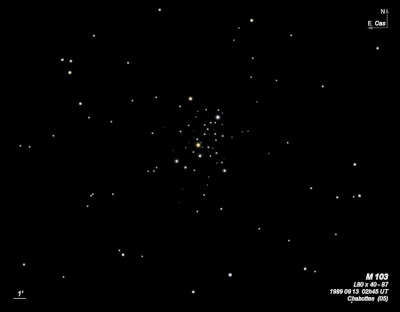
Pierre Méchain discovered M103 = NGC 581 = h126 in April 1781. Messier added it at the last minute to his 1781 catalogue (published in the 1784 Connaissance des temps), but since the discovery occurred after the manuscript was sent out for publication, he wasn't able to provide visual confirmation or specific coordinates.
William Herschel observed the cluster on 8 Aug 1783 and wrote, "14 or 16 pretty large stars with a great many eS ones. Two of the large ones are double, one of the 1st the other of the 2nd class. The compound eye glass shews a few more that may be taken into the cluster so as to make about 20. I exclude a good many straggling ones, otherwise there would be no knowing where to stop."
John Herschel included M103 in his Slough Catalogue (h126) but only referenced ∑131, Struve's entry (1825) from his catalogue of double stars, so he was apparently unaware of the equivalence with M103. He reported it on 29 Sep 1829 (sweep 213) as "A fine cl; R; rich; rather coarse; 6 or 8' diam; stars 10...11m. One of Struve's "acervi".
300/350mm - 13.1" (10/20/84): 50-60 stars in cluster, fairly rich. Includes several bright stars in a distinctive triangular wedge shape containing STF 131 at the NW edge (7.3/9.9/11.8 at 14" and 28" lined up to the SE) , colorful orange mag 8.4 SAO 11826 (M2-class supergiant) just SE of center, mag 8.9 SAO 11824 1' S of SAO 11826 and mag 8.2 HD 9365 on the SE edge [not a cluster member].
Notes by Steve Gottlieb
NGC 185
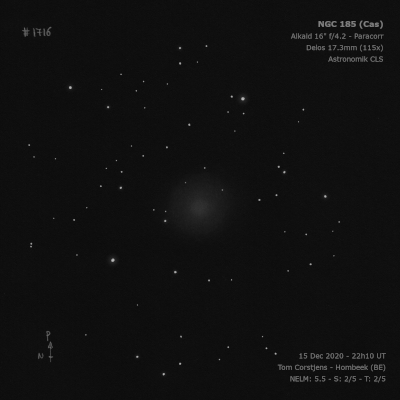
William Herschel discovered NGC 185 = H II-707 = h35 on 30 Nov 1787 (sweep 786) and recorded "pB, vL, irr R, vgmbM, resolvable, 5 or 6' diameter." The first observation with LdR's 72" on 28 Mar 1848 reads "Resolved by a power of 800, although the night was rather hazy." This is a good example of how preconceptions that nearly all nebulae were resolvable influenced the results. The NGC position is accurate.
James Keeler first photographed the galaxy using the Crossley reflector at Lick before 1900. It was described (1918 Curtis publication) as "rather irregular slightly oval, 3' long; there are two curious rifts near the nucleus; it appears to be an irregular spiral. The nebular matter is faint and diffuse. A star of mag 14 is north of the very faint nucleus."
In 1944 William Baade announced that NGC 185, along with NGC 147, were members of the Local Group (1944ApJ...100..147B) when they were resolved into stars on plates take with the 100-inch at Mt Wilson. In an unusual situation, Baade requested that an actual photographic print of NGC 185 was bound in his ApJ paper to demonstrate resolution, as detail was lost with an ordinary halftone illustration.
200/250mm - 8" (10/4/80): fairly faint, fairly large, diffuse, NGC 147 58' WNW.
400/500mm - 17.5" (10/13/90): bright, very large, slightly elongated ~E-W, broad concentration but no nucleus. Three mag 14 stars are at the W, NW and SW ends. Higher surface brightness than NGC 147. The brightest globular is located 8' N of center and is a marginal object at high power (see description). This is a satellite system of M31 and a Local Group member at a distance of 2.15 million light years.
600/800mm - 24" (9/14/12): Hodge V is the brightest globular cluster in NGC 185, first identified by Paul Hodge in his 1974 paper "Photometry of the Globular Clusters of NGC 185" (PASP, 86, 289). At 325x and 450x it appeared as an extremely faint star (V = 16.7), forming the southern vertex of a small equilateral triangle with a mag 14.5 star 20" N and a mag 15 star 20" NW. This extragalactic globular was repeatedly glimpsed for brief moments and a couple of times it could be held for a few seconds. Situated 3.8' NE of the center of NGC 185 and outside the visible halo of the galaxy.
Notes by Steve Gottlieb
NGC 147
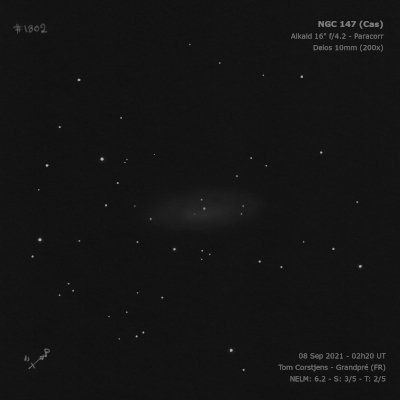
I first identified two mag 13 stars at 1' separation oriented N-S, which are situated 5' SSE of the center of NGC 147. These stars are just outside the halo of the galaxy. A mag 14.7 star is 1' further NW, forming an obtuse isosceles triangle with the two mag 13 stars. Hodge 3 is 41" N of the mag 14.7 star and nearly forms the 4th vertex of a parallelogram with these three stars.
John Herschel discovered NGC 147 = h29 on 8 Sep 1829 and recorded "vF; vL; irr R; 4..5' diam; loses itself insensibly; has a *11m in the centre." Bindon Stoney, LdR's observer on 25 Oct 1851, logged "L, vF neby, round a * 12m. I suspect it is a spiral of the faintest class, perhaps h 29." On 21 Aug 1852, George J. Stoney wrote, "Involves some stars, one of about 12th or 13th magnitude, E; vF."
In 1944 William Baade announced that NGC 147, along with NGC 185, were members of the Local Group (1944ApJ...100..147B) when they were resolved into stars on plates take with the 100-inch at Mt Wilson. NGC 147 is considered a satellite system of M31 at a distance of 2.3 million light years.
200/250mm - 8" (8/28/81): very faint, moderately large, slightly elongated, diffuse.
400/500mm - 17.5" (10/13/90): fairly faint, very large, elongated almost 2:1 SSW-NNE, 5'x3', very low almost even surface brightness. A mag 13.8 foreground star is superimposed just north of center. The halo gradually fades into background.
17.5" (8/29/92): appears larger (8'x4') using 20mm Nagler in the White Mountains (elevation 12,500 ft).
600/800mm - 24" (1/1/16): Hodge III is the brightest globular cluster in NGC 147 at V ≈ 16.5. At 450x and 500x it only occasionally popped but was verified at the same position using a detailed finder chart.
Notes by Steve Gottlieb
NGC 896
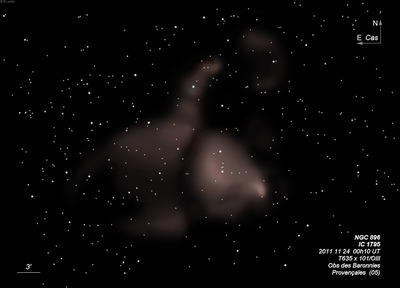
E.E. Barnard discovered IC 1795 photographically, probably with the 6" Willard lens. The IC description is simply "Patch of neby".
400/500mm - 17.5" (11/27/92): observation at 100x using an OIII filter. This is the northeastern section of a large emission complex with NGC 896. Very large, about 10' diameter, roundish, fainter than NGC 895 but still moderately bright. A mag 9.5 star is embedded at the SE edge and several fainter stars are superimposed. A small detached piece of nebulosity is visible about 10' N with a mag 11.5 off the south edge and several fainter stars are at the edges or superimposed. NGC 896 and IC 1795 form the NE component with the IC 1805 ("Heart Nebula") complex spread out to the SE.
Notes by Steve Gottlieb
IC 10
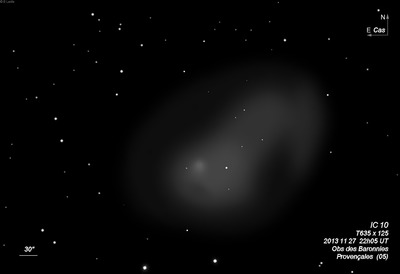
Lewis Swift discovered IC 10 = Sw. VII-1 on 8 Oct 1887 and recorded "F * involved in vL, eeeF nebulosity, eee difficult. In line with 2 stars of equal mag which with a 3rd forms a right angled triangle."
Nicholas Mayall first recognized IC 10 as a galaxy in 1935 ("An Extragalactic Object 3° from the Plane of the Galaxy" in PASP, 47, 317). In 1936, Hubble suggested it might be a member of the local group and called it "One of the most curious objects in the sky" in his 1936 classic "The Realm of the Nebulae." This wasn't confirmed until 1996 using Cepheid variables and the current distance estimate is ~2.5 million l.y. This irregular dwarf galaxy is probably a member of the M31 satellite system and it lies only 3.3 deg from the galactic plane.
300/350mm - 13.1" (11/5/83): very faint, moderately large, elongated NW-SE. Unusually low even surface brightness. A mag 13 star is superimposed near the center. Located in a very rich star field just 3.3° from the galactic plane! Member of the Local Group.
400/500mm - 18" (9/6/10): this local group dwarf Irregular was immediately picked up at 108x (without a printed finder chart) as a large, low surface brightness hazy glow, ~4'x2.5', roughly elongated NW-SE, though the outer extent increased with averted vision and careful viewing. A mag 12.7 star is superposed to the southeast of center and a few stars are on the northwest end. The 1.5' region surrounding the mag 12.7 star is the brightest portion of the galaxy and the W and NW regions have a very low surface brightness and appeared irregular and patchy. Located 12' NE of mag 7.3 HD 486 and just north of a right triangle of mag 10-11 stars
Using 175x, a very small 15" knot was clearly visible about 50" following the mag 12.7 star. This knot is a giant HII region (site of violent starburst formation) catalogued by Hodge and Lee (1990) as HL 111. At 285x with direct vision a faint star at its west edge was similar in visibility, but with averted vision the HII knot was more evident. I probably viewed the brightest component 111c, which has a diameter of 11", of this HII complex. Two mag 10.5 stars 3.5' S and 5.5' S of the galaxy (part of the right triangle mentioned above) provide a useful guide to pinpoint the location of HL 111. The HII region is directly on a line and equally spaced with these stars -- just follow the stars to the small knot.
18" (7/15/07): at 225x this Local Group member (M31 subgroup) appeared faint, fairly large, slightly elongated NW-SE, ~4.5'x3.5', low even surface brightness except fades at the edges. A mag 13 star is superimposed west of center and a fainter star follows. Located 1.4 degrees ENE of mag 2.3 Beta Cas (Caph).
18" (10/8/05): picked up fairly easily at 115x as a large, low surface brightness hazy region with a mag 13 star superimposed. Good view at 160x using the Meade 14mm Ultrawide. Appeared faint, large, slightly elongated, ~4'-5' diameter (though no distinct borders) with a patchy, mottled appearance, very weak concentration. Several faint stars (besides the mag 13 star) are superimposed. Situated within a rich star field and appears similar to a low surface brightness emission or reflection nebula.
Notes by Steve Gottlieb
NGC 7635
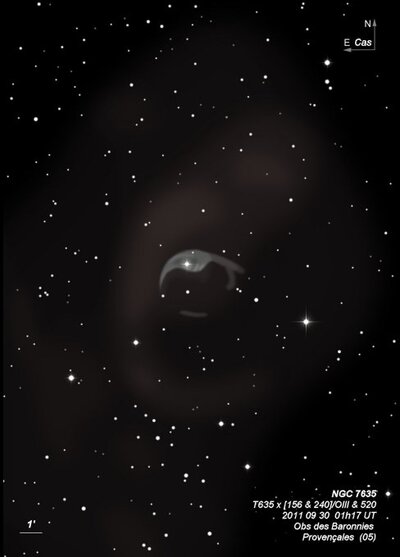
William Herschel discovered NGC 7635 = H IV-52 = h2235 on 3 Nov 1787 (sweep 773) and recorded "a bright star with F nebulosity; but I saw it too late to verify it, as in the north I cannot follow the stars. I rather suspect a deception." On 26 Nov 1788 (sweep 887) he added "a star about 9m with vF nebulosity of very little extent."
Hubble considered NGC 7635 a giant planetary nebula in his 1922 paper "A general study of diffuse galactic nebulae." Even in the early 1970's it was considered a possible or probable planetary (see ApJ, 167, 491-498 (1971)), though it was not included in Kohoutek's CGPN.
John Mallas coined the nickname "Bubble Nebula" in his Aug/Sep 1963 article "Visual Atlas of Planetary Nebulae-VI", published in the "Review of Popular Astronomy".
300/350mm - 13.1" (9/29/84): unusual appearance - surrounds a mag 8 star with a mag 7 star nearby to the SW. The nebulosity mostly appears north of the mag 8 star with a suspected dark lane to the north of this nebulosity. Very faint nebulosity appears close north of this lane. The main section hooks around the involved star to the east.
400/500mm - 17.5" the "Bubble Nebula" extends mainly north of the ionizing emission-line star, mag 8.7 BD+60°2522 (O6.5-type supergiant). Dark lanes are suspected to the north with very faint nebulosity just north of this gap. The main piece of nebulosity curves away from the involved star towards the east but appears brightest at the western edge near the bright star. Only the portion of the rim extending from north to east of the 3' diameter "Bubble" was seen (not the south edge). The view improved with both OIII and UHC filters but not dramatically. Located 6.5' NE of mag 7 HD 220057. M52 lies 35' NE.
Notes by Steve Gottlieb
IC 1747
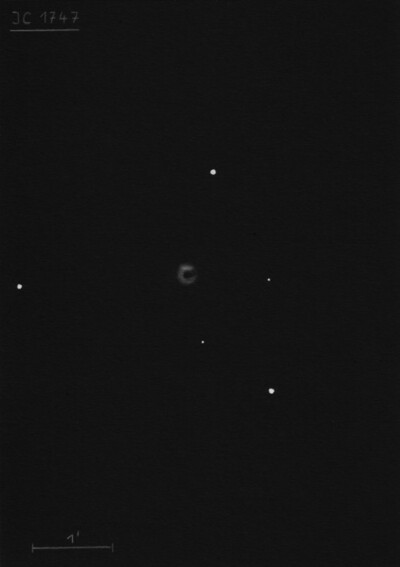
Williamina Fleming discovered IC 1747 = HN 103 in 1905 at Harvard College Observatory, while classifying stars by examining photographic objective-prism spectra. A note in the 1905 Harvard College Observatory Circular No. 98 ("Stars Having Peculiar Spectra") reads "assumed to be the following and southern of two faint and difficult objects, which also appears somewhat hazy. The spectrum consists of a bright band having wavelength of about 5000. Therefore, this object has been assumed to be a gaseous nebula."
Based on Crossley photographs, Heber Curtis (1918) described, "central star about mag 14. Nearly round disk 13" in diameter, with an indistinct ring effect, strongest in the north and south and fading out along an axis in pa 90° [E-W]."
200/250mm - 8" just non-stellar at 125x. Definite disk at 220x and possibly slightly elongated NW-SE. Three mag 11 stars on a line are to the NE.
300/350mm - 13.1" (12/7/85): at 166x without a filter appeared moderately bright, very small, round, about 12" diameter. Takes 360x but no structure is visible. Surrounded by three mag 13 stars 0.8' N, 1.0' SW and 1.3' E of center. Three collinear mag 11 stars oriented SSW-NNE begin 3' NE. Located 30' SE of mag 3.3 Epsilon Cas.
400/500mm - 18" (11/17/08): immediately picked up at 175x as a small bluish disc, ~12" diameter. Situated within a distinctive 20' curving chain of stars that passes through much of the field. Very good contrast gain using an OIII filter. At 450x, the planetary is slightly elongated WNW-ESE, ~15"x12", and weakly annular. At 800x it appeared irregularly brighter along the rim with a knotty structure, particularly along the northern half. Located 30' SE of mag 3.4 Epsilon Cas.
900/1200mm - 48" (10/27/16): at 610x; very bright, small, round, aqua (blue-green) color, 12" diameter. The planetary is annular (though not a high contrast) with a darker center. The rim is unevenly lit, slightly mottled, and brighter along the entire eastern side.
48" (10/23/11): at 375x appeared as a very bright, small, bluish planetary with an irregularly brighter rim, slightly fainter on the west side of the rim. At 488x, this is a very interesting annular planetary with a relatively thick brighter rim that appears clumpy and a dark center. The rim dims, though, on the west side, so the annularity is incomplete. Overall the impression is a thick crescent spanning 270°.
Notes by Steve Gottlieb
IC 59
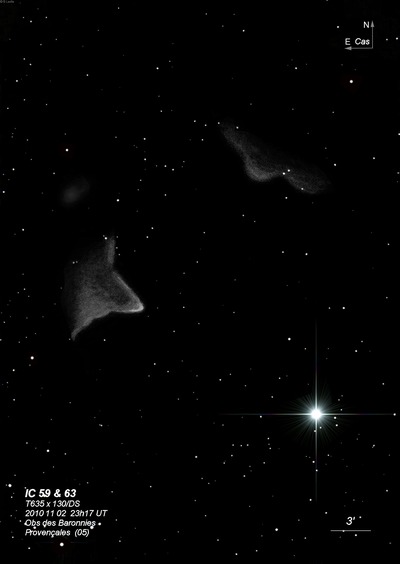
IC 59 and 63 were discovered independently on photographs taken by Max Wolf (probably towards the end of 1893) as well as E.E. Barnard on a plate taken 2 Feb 1894 of 3 hours exposure. Wolf announced the discovery in AN 134 [3214], 365 (1894), "Ueber einige neue Nebelflecke" (Some New Nebulae). Barnard stated "before beginning this [second] exposure [on 6 Feb 1894], I carefully examined the sky close to Gamma with the 12-inch and a power of 80, with a field of 42'. The sky was fine. It was with the utmost difficulty that I could see these two nebulae. They were excessively dilute and faint, and never would have detected if the photographic plate (from 2 Feb) had not revealed them." Roberts photographed the Gamma Cas area earlier on 17 Jan 1890, but his image shows no nebulosity and he failed to mention nebulosity in the field.
300/350mm - 13.1" very faint, fairly large, very diffuse, visible with averted only. Forms a pair with IC 63.
400/500mm - 17.5" (11/1/86): located 20' N of Gamma Cassiopeia. This emission nebula is larger than IC 63 but has a lower surface brightness. Easy with averted vision and appears large, elongated ~N-S, with a fairly even surface brightness. IC 63 lies 20' SE.
Notes by Steve Gottlieb
IC 63
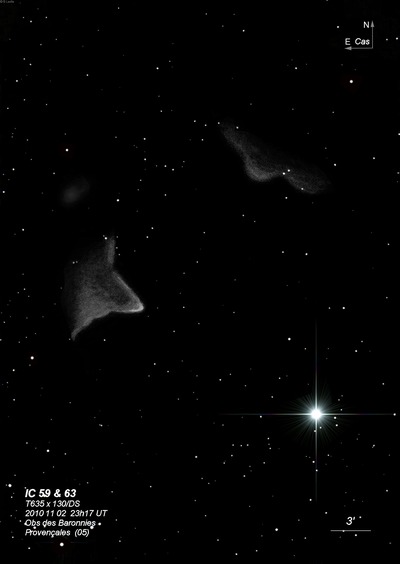
IC 59 and 63 were discovered independently on photographs taken by Max Wolf (end of Dec 1893) as well as E.E. Barnard (6 Feb 1894). Wolf announced the discovery in AN 134 [3214], 365 (1894), "Ueber einige neue Nebelflecke" (Some New Nebulae).
300/350mm - 13.1" very faint, fairly large, very diffuse, fan-shaped. Forms a pair with IC 63.
400/500mm - 17.5" (11/1/86): distinct fan-shaped nebulosity extending east and NE with the vertex at the west end. The southern border (extending E-W) has a sharper edge. Brighter than nearby IC 59 in the field 20' NW. Located 20' NE of Gamma Cassiopeiae.
Notes by Steve Gottlieb
NGC 129
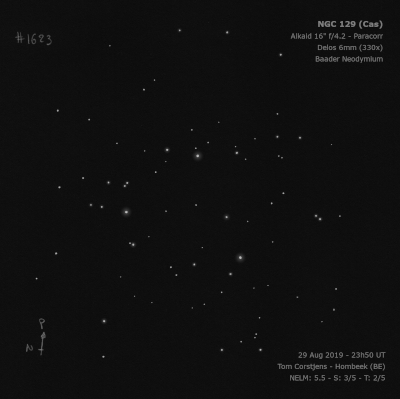
William Herschel discovered NGC 129 = H VIII-79 = h24 on 16 Dec 1788 (sweep 892) and logged "a coarsely scattered cluster of large stars, mixed with smaller ones, not very rich." JH reported "a * 9m about middle of a vL, coarse sc rich cluster of *s 9..13 which more than fills field."
200/250mm - 8" ring-shaped open cluster with stars mag 9-13. There is a line of stars to the north on the east edge.
400/500mm - 17.5" (8/29/92): 60 stars mag 10-15 in the 8'x6' central region of the cluster formed by an isosceles triangle with vertex at the south end. Each side of this triangle includes a mag 10 star and most cluster members are contained within triangle. No real boundaries and many mag 15 stars are at the edges of this triangle. Mag 6.0 SAO 21457 lies 10' S. Berkeley 2 lies 35' NW.
600/800mm - 24" (1/4/14): at 125x and 260x, ~100 stars resolved in a 10'x5' region elongated N-S. The cluster is more compressed on the south side, where three mag 9 stars (HD 236429, HD 236433 and HD 236436), form a near equilateral triangle with sides of 3'-4'. Fainter stars nearly complete an oval ring with these stars, though several stars are also inside of the ring. Starting with the mag 9 star at the south end of the triangle, a number of the brighter stars form two strings extending NNW and NNE, so the overall appearance is an elongated wedge. Two mag 9.5/10 stars are at the N tips of these strings and the eastern string is richer and better defined. Scattered mag 12-15 stars fill the interior of the wedge, with a couple of brighter stars on the south end, which is more eye-catching .
Notes by Steve Gottlieb
NGC 654
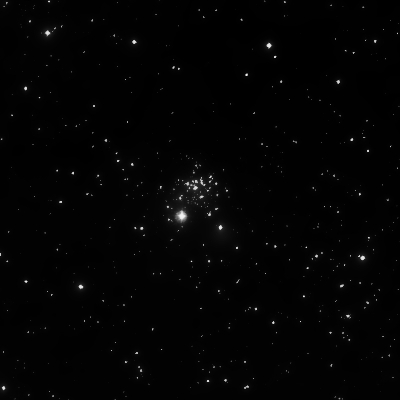
William Herschel discovered NGC 654 = H VII-46 = h145 on 3 Nov 1787 (sweep 774) and noted "a small cluster of pretty large stars, pretty rich." John Herschel described on 5 Oct 1829 (sweep 216), "a fine rich cluster; stars 11...14m; 3' dia; irreg fig; place that of the most compressed part; one star 6.7 mag, south-following the center, is ruddy."
200/250mm - 8" rich in faint stars including doubles. A mag 7 star is at the southeast edge.
300/350mm - 13.1" (10/20/84): 35 stars, rich, includes several doubles. Located just northwest of mag 7.3 HD 10494, which is a likely member.
Notes by Steve Gottlieb
NGC 225
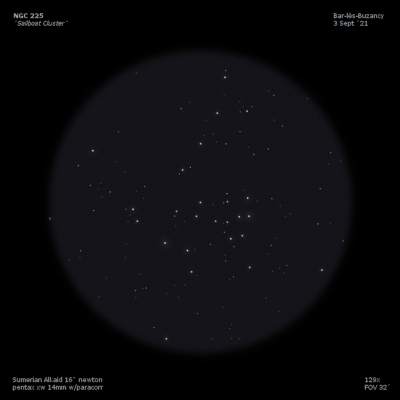
Caroline Herschel discovered NGC 225 = H VIII-78 = h52 on 27 Sep 1783 (and seen again on 30 Oct 1783 and 23 Feb 1784) with her 4.2" comet seeker reflector. The cluster was first seen by William on 11 Mar 1784 before he began the evening's sweeps. On 26 Nov 1788 (sweep 887), he recorded, "a good many coarsely scattered L stars of an equal size, they take up a space of 15 or 20'."
200/250mm - 8" two dozen stars in a cluster, fairly bright but scattered, no dense spots.
400/500mm - 17.5" (11/2/91): about two dozen stars at 100x in a 12' diameter. Bright but scattered. Outline forms an isosceles triangle with the vertex at west edge and the long base on the east side. Most stars are mag 10-11 and evenly spaced. The cluster appears completely resolved. Only one fairly close double star in group. Just ENE of the main group is a line of five mag 9 stars oriented N-S.
600/800mm - 24" (1/4/14): bright, large, scattered group of ~50 stars in 10' group. Includes 15-18 brighter stars that stand out (mag 9.5-11). A ragged N-S string of stars defines the eastern border of the cluster. There are no rich subgroups and a lack of faint stars.
A detached group of stars is off the north side, but these stars do not appear to be part of the cluster. vdB 4, a very faint reflection nebula, is involved with these stars though it was not noticed.
Notes by Steve Gottlieb
NGC 659
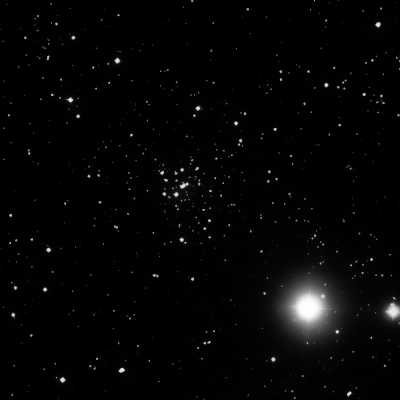
Caroline Herschel discovered NGC 659 = VIII-65 on 27 Sep 1783 with her 4.2-inch comet-seeker reflector. She observed it again on 30 Oct 1783. William Herschel independently discovered the cluster on 3 Nov 1787 (sweep 774) and logged "a small cluster of small stars, not very rich." In his PT catalogue, he noted "Caroline Herschel [discovered it in ] 1783."
300/350mm - 13.1" (10/20/84): ~20 stars in cluster, not impressive. Located 80' E of M103.
13.1" (11/5/83): 18 stars at 166x over haze. In field to NW of NGC 663.
Notes by Steve Gottlieb
NGC 7790
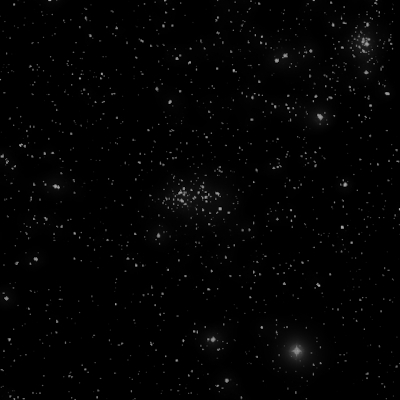
William Herschel discovered NGC 7790 = H VII-56 = h2285 on 16 Dec 1788 (sweep 892) and recorded "a pretty compressed cl of small stars of several sizes; considerably rich; E nearly in the parallel. 5 or 6' long." JH reported "a double star in the p part of a pretty rich cluster; diam 4'; stars 12...13m; the f part most compressed."
300/350mm - 13.1" (9/29/84): largest of three open clusters on a line. Roughly two dozen stars mag 10-15 are resolved in a 5'x2' region elongated E-W. A mag 10 star is about 4' SE of the center and a couple of similar stars are on the west side of the cluster. The slightly fainter cluster NGC 7788 is located 15' NW. The three clusters span about 1° including Harvard 21.
400/500mm - 18" (11/26/03): ~30 stars resolved in a 4.5'x2.5' region, fairly rich. Three mag 11 stars are along the west side of the cluster and a slightly brighter mag 10 star is ~4' SE of the main group. This cluster is slightly larger than NGC 7788 ~16' NW. Fainter Be 58 lies 20' SE.
Notes by Steve Gottlieb
NGC 436
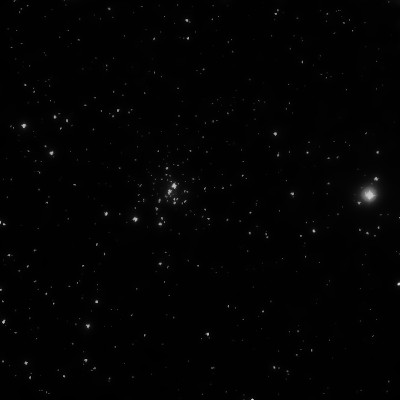
William Herschel discovered NGC 436 = H VII-45 on 3 Nov 1787 (sweep 774). His summary description is "a small pretty compressed cluster of stars, not rich, iF, like a forming one." The NGC position is accurate.
400/500mm - 17.5" (8/16/93): 40 stars mag 10-15 in 4' diameter. Includes a rich 1.5' region with 15 stars with a nice triple star in a tight equilateral triangle. Other brighter stars in this grouping form a pentagon outline. Three equally spaced mag 9-10 stars oriented E-W begin just off the south side. Several sprays of stars emanate out in various directions from the central region.
17.5" (11/2/91): fairly bright and compact, ~30 stars mag 9-14 at 220x in a 4' diameter, distinctive group. Just north of center is a tight triple star with 4th star to E, also second trio of stars is close south. A mag 9 star near the south edge is collinear with two mag 9 stars 2' SE and 4' SE all equally spaced.
600/800mm - 24" (1/4/14): at 200x, ~50 stars are resolved in a rich, 4' group that is well-detached and distinctive. The main group is confined within a triangular outline with a mag 10.9 star at the S end, a mag 12 star at the W end and a mag 11.5 star at the N end. Contains a very rich central region ~1.5' diameter and includes STI 1550, a close triple with components 11.2/11.3/11.8 at 9" and 12". Another uncatalogued pair is just 0.6' S of STI 1550. Two mag 9.5/10 stars are collinear to the east of the mag 10.9 star at the south end.
Notes by Steve Gottlieb
NGC 381
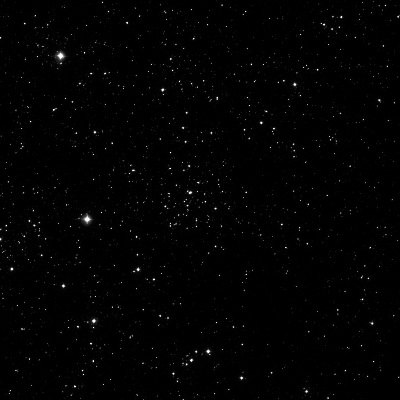
Caroline Herschel is generally attributed with the discovery of NGC 381 = H VIII-64 on 27 Sep 1783, though according to an article in Aug 2007 S&T, Caroline's discovery preceded Gamma Cass instead of following and likely refers to NGC 189 instead. Her brother William probably discovered the cluster on 3 Nov 1787 (sweep 774) and noted "a forming cluster of pretty compressed stars." In his second published catalogued he added "C.H. disc[overy] 1783".
200/250mm - 8" ~30 stars in a circular group, bright curving string to the north. A mag 8 star is 10' E.
400/500mm - 17.5" (8/16/93): 40 stars mag 11-15 in loose 6' diameter, stands out best at 100x. The brightest mag 10.8 star is part of a triple along the north side. Fairly uniform in mag 12/13 stars with a scattering of faint stars, fairly even distribution with no rich regions. Not recognizable as a cluster at 220x.
17.5" (11/2/91): about three dozen stars in 6' diameter, fairly faint, roughly a circular group. Consists mostly of mag 12/13 stars. Includes a triple star (10.8/12.5/13 at 8"/~3") and two mag 11 stars on the west side. Several stars are arranged in strings. Relatively few stars in center. A line of mag 10 stars trail off to the north edge of field and the mag 10 star at the end of the string 11' N is a close double star.
600/800mm - 24" (1/4/14): nice group of ~75 stars, fairly uniformly distributed in a 6' group. A triple star (STI 185 = 10.8/12.5 at 9" and a third closer companion) is just north of center. The cluster is roughly circular with no denser patches, but it does include a number of faint stars so the appearance is fairly rich. Pretty well detached in the 50' field at 125x (less so on the north side).
Notes by Steve Gottlieb
NGC 133
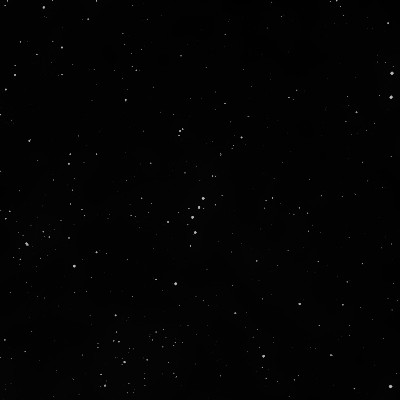
Heinrich d'Arrest discovered NGC 133 on 4 Feb 1865 with an 11" refractor at Copenhagen and recorded (single observation) a "double star in a group of scattered stars, mag 10 and fainter. Found while observing h28 [NGC 146]. The double star is mag 10 and 11 at a separation of 6"." His position and description matches this weak cluster.
200/250mm - 8" (8/16/82): group of 8 stars in "Y" asterism, in field with open cluster NGC 146 and King 14.
400/500mm - 17.5" (10/13/90): about 15 stars including 5 brighter stars forming a "Y" asterism and 10 faint stars. One of the brightest stars is a very close double star (9.7/11.3 at 6") and a curving lane of very faint stars passes through this double star, not rich. This is the poorest of three clusters just north of Kappa Cassiopeia.
Notes by Steve Gottlieb
NGC 559
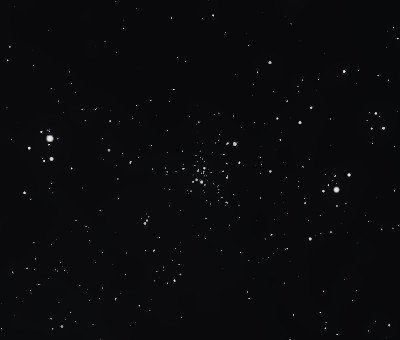
William Herschel discovered NGC 559 = H VII-48 = h124 on 9 Nov 1787 (sweep 777) and noted "a compressed cluster of some pL and many vS stars, iR, 6' or 7' diameter." John Herschel independently found this cluster on 5 Oct 1829 and described "A fine rich cluster 5' diameter, irregular." He made a clerical error in reducing the PD, which is 1° too far south (error caught by Auwers) and assumed this was a new discovery when compiling the Slough Catalogue. This error was corrected in the General Catalogue (h124 = H VII-48).
400/500mm - 17.5" (11/2/91): about 50 stars mag 10-15 at 220x in a 6'x4' region. Fairly compact and rich with an irregular outline. Includes a thin isosceles triangle of three mag 10 stars with the base to the south. The southeast star in this base is a close unequal double. A number of the stars are arranged in strings including four mag 13-14 stars over haze trail from base to the north. Also four mag 8/9 stars precede the cluster to the northwest in a 10' string.
Notes by Steve Gottlieb
NGC 743
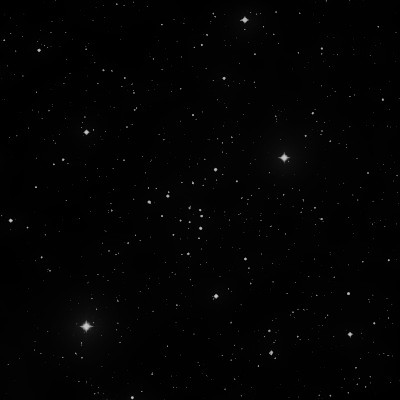
John Herschel discovered NGC 743 = h170 on 29 Sep 1829 and recorded a "double star in the following part of a L, poor, triangular cluster of 15 or 20 stars 10...13m.".
400/500mm - 17.5" (11/26/94): bright, distinctive but scattered group in a triangular outline. Consists of two dozen stars in a 6' diameter including 10 brighter mag 9-11.5 stars. The brightest star is mag 9.1 SAO 22794 is at the NW end and a distinctive line with three mag 10 stars heads SE and includes a fairly wide uneven double star (John Herschel's h1098 = 10/12.5 at 12"). Two mag 8 stars to the NW (mag 7.9 SAO 22785) and SW (mag 8.3 SAO 22796) are collinear with the sides and form a 10' triangle with the eastern vertex of the cluster. The classification of this group as a true cluster is uncertain.
Notes by Steve Gottlieb
NGC 278
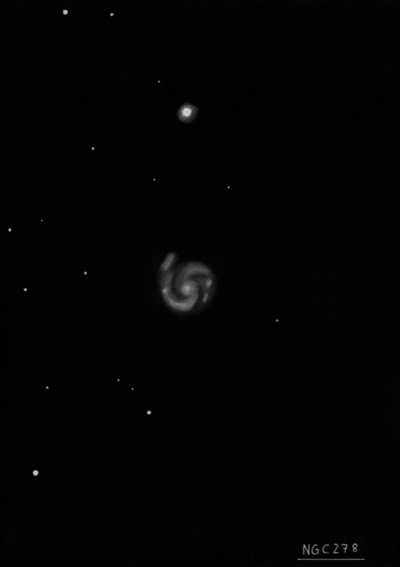
William Herschel discovered NGC 278 = H I-159 = h71 on 11 Dec 1786 (sweep 644) and logged "vB, R, vgmbM, about 1.5' dia., about 1' south of a pretty considerable star." On 30 Nov 1787 (sweep 786) he noted "cB, R, vgbM, about 1 1/2' dia." R.J. Mitchell, observing with LdR's 72" on 16 Oct 1855, recorded "pB, R, N, light certainly patchy, but I can distinguish no stars in it. It is a right handed spiral?? I suspect a F* cl following the nebula."
400/500mm - 17.5" (10/13/90): bright, moderately large, round, bright core, stellar nucleus. Located 3' S of mag 8.8 SAO 36725.
900/1200mm - 48" (10/27/16): at 610x and 813x; NGC 278 is extremely bright, large, the halo has a squarish appearance, ~1.4' diameter, high surface brightness. Very well concentrated with an intense round core that increases to the center. Sections of the two main thick spiral arms are visible, particularly along the north and south portion of the halo. Slightly darker lanes outline the inside of the arms. The inner arm sections are only noticed as subtle brighter patches. A well defined, small knot is on the east side of the halo [25" from center] and a second small knot is on the northeast side [23" from center]. These two star-forming complexes are catalogued as X-ray sources in NED. I also noted a third object at the NE edge, but at this position on the HST image is a very faint star.
Notes by Steve Gottlieb
IC 289
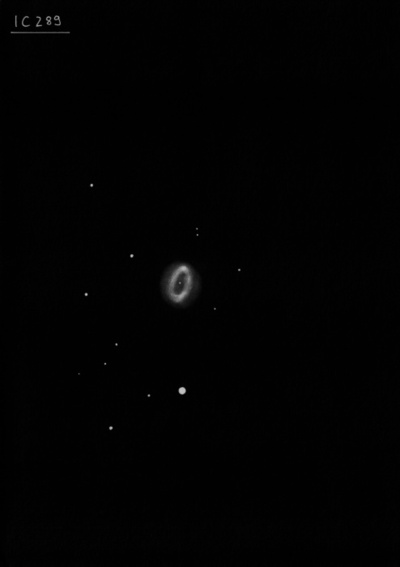
Lewis Swift discovered IC 289 = Sw. VIII-15 on 2 Sep 1888 and recorded "pB; pL; R; bet 2 vF st."
Hubble included this object in a 1921 paper titled "Twelve New Planetary Nebulae" in PASAP, Vol 33, No 193, p. 174 available at http://cdsads.u-strasbg.fr/cgi-bin/nph-iarticle_query?1921PASP...33..174H. Included in his table are NGC 2818, NGC 6072, NGC 7048, NGC 7635, IC 289, IC 1470, IC 4670, Hb 4, Hb 5, Hb 7, Hb, 8 and Hb 12.
200/250mm - 8" at 100x and UHC filter this planetary is very faint, very small. Situated near the tip of two converging rows of mag 10-12 stars. Several difficult positive sightings made from poor transparency in El Cerrito!
300/350mm - 13" (12/7/85): at 79x and OIII filter appears faint, small, round. At 166x and UHC filter can just hold steadily with averted vision, fairly small, almost round.
400/500mm - 17.5" (1/16/02): at 140x, IC 289 was seen as a fairly faint, 35" to 40" disc with a modest contrast gain using a UHC filter. Situated 2' N of a mag 10 star and near the tip of two curving strings of stars which head north and NW from IC 289. Excellent view at 380x - the planetary is slightly elongated and has a mottled appearance with a marginally brighter rim, particularly on the W or NW side, giving an impression of weak annularity. At moments, there was a brief sparkle at the center, possibly the central star. A mag 14 star is 45" NE of center and a mag 13 star lies 1.3' following.
900/1200mm - 48" (10/27/16): at 610x unfiltered; bright, fairly large, slightly elongated NW-SE. Annular with an irregularly brighter rim that is brightest on the northwest side. The northern end is slightly brighter in general (less than a 90° arc). A faint central star was visible most of the time. We didn't look for the outer halo at lower power. IC 289 resides in a rich star 1.8' NNW of a mag 10.1 star.
48" (10/25/14): at 375x unfiltered; fairly bright, fairly small, slightly elongated NW-SE, 0.6'x0.5'. Weakly annular with a slightly brighter rim and irregularly lit darker center that contains a very faint central star. A thin, very low surface brightness outer halo is more elongated along the minor axis, creating a roughly circular halo.
Notes by Steve Gottlieb
NGC 1027
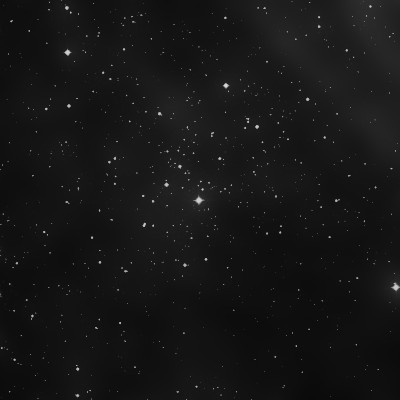
200/250mm - 8" includes a dozen stars mag 8 to 12.5. Fairly small, rich, over unresolved background haze.
400/500mm - 17.5" (11/27/92): 90 stars in 15' diameter, fairly scattered but still a striking cluster. Surrounds mag 7.0 SAO 12402 and includes about 15 mag 10-11 stars and many mag 13-14 stars. A number of the stars are arranged in spiraling rays emanating from the dominant star. The cluster is composed of a mixture of bright and faint stars.
Notes by Steve Gottlieb
NGC 637
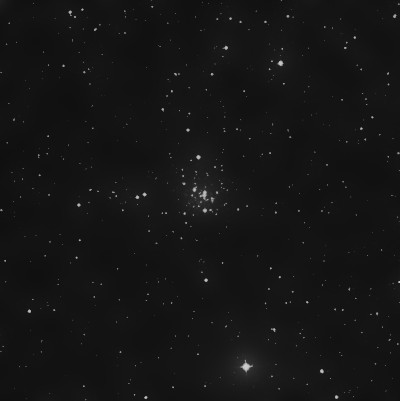
William Herschel discovered NGC 637 = H VII-49 on 9 Nov 1787 (sweep 777) and noted "a cluster of some cL stars and many eS, so as hardly to be visible. The large ones arranged in circular order 3' or 4' diameter."
200/250mm - 8" (1/1/84): 10 stars in cluster includes four mag 10 stars and fainter, mottled, over haze.
300/350mm - 13.1" (12/7/85): rich cluster of two dozen stars arranged in an arc. There are five bright stars including a mag 10/11.2 double star at 9" separation.
400/500mm - 18" (10/25/08): very pretty cluster at 283x. The central 2.5' region is rich and contains roughly 3 dozen stars including a mag 10.2/11.4 double (STI 264 = ADS 1342) at 9.5" separation. A third mag 11 star forms a wide trio 46" to the south. An arc or "C" shaped curve of stars passes through the central double and opens to the north. A chain of brighter stars begins at the center of the open end of the arc (on north side) and zigzags to the north and NE. A wide bright double (23" separation) sits at the east end of the central region. Finally another fainter linear chain of stars heads to the west of the central region. Within a 5' region, 50-60 stars are resolved.
Notes by Steve Gottlieb
NGC 189
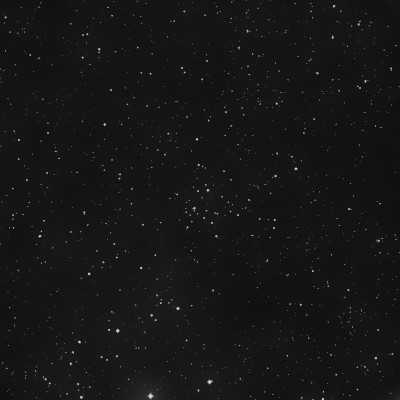
Caroline Herschel probably discovered NGC 189 = h36 on 27 Sep 1783 although William mistakenly attributed her with the discovery of NGC 381. This is unlikely as the object she found preceded Gamma Cas, while NGC 381 follows. Although William made no observations, John Herschel independently discovered the cluster on 27 Oct 1829. He logged, "Cl, L; p rich; irreg R; 8' diam; straggling; *s 11...15m."
200/250mm - 8" (11/13/82): about two dozen stars, moderately large, irregular shape, scattered, haze.
400/500mm - 17.5" (11/27/92): 30 stars mag 10-14 in 6' diameter, weakly compressed, no dense areas but appears to have some unresolved background haze. Elongated E-W due to a couple of strings extending to the west. A 6'x5' parallelogram of four mag 9 stars in the field to the south. Not an impressive cluster.
600/800mm - 24" (1/4/14): well detached, roundish group of stars at 125x. Using 260x, ~40 stars are resolved in a 5'-6' group. There are several pairs and tight groupings. Many of the stars are in a richer 3' inner group, generally arranged in a ring and including h 1043 = 11.6/12.7 pair at 12" (oriented N-S). A few of the brighter stars, though, form the 6' outline. A distinctive quadrilateral of stars is ~6' NW.
Notes by Steve Gottlieb
NGC 433
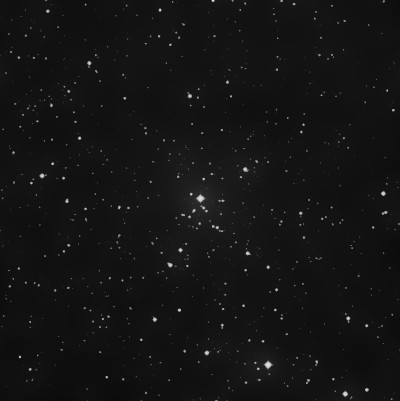
John Herschel discovered NGC 433 = h94 on 29 Sep 1829 and described a "star 8m the chief of a small loose cluster." The mag 9.3 star is on the north side of the cluster. Robert Ball observed the cluster using the 72" at Birr Castle and logged "Loose CL. consisting of 50 or 60 stars of various sizes from about 8 mag down."
400/500mm - 17.5" (8/16/93): 30 stars mag 10-14 in a 6' triangular outline although very few stars are inside the triangle. The mag 10 star at the north vertex is surrounded (mostly on the south side) by a rich subgroup of faint stars, including at least three close multiple systems. Mag 8.7 SAO 22122 is just south of the triangle and 8' SSW of the mag 10 star in the cluster.
600/800mm - 24" (1/4/14): the most distinctive part of this cluster is a mag 9.3 star surrounded by a 2' cloud (mostly south) of ~15 mag 13-14 stars. A mag 11 star is at the NW corner, a 50" pair of mag 11 stars is at the SE end and a mag 11.5 star is at the SW corner. A small string of stars extends from the mag 9.3 star to the southwest.
Notes by Steve Gottlieb
NGC 146
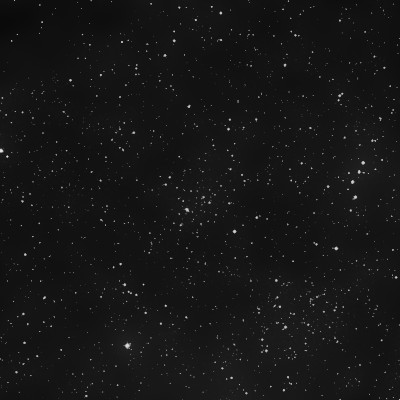
John Herschel discovered NGC 146 = h28 on 27 Oct 1829 and recorded a "loose cl; s 11 and 12m; 10' diam; place that of a double + (h 1033) whose RA is erroneously stated in my 4th catalogue."
200/250mm - 8" (11/28/81): includes a few mag 10 stars, many mag 12 stars and fainter stars over haze. Located 22' N of a mag 4 star. NGC 133 is in the field to the WNW and King 14 is close SW.
400/500mm - 17.5" (10/20/90): about 30 stars in a fairly large group about 10' diameter. Includes a close mag 10 pair at 7" separation, 10 stars mag 12-13 and 20 stars mag 14-15. Third of three open clusters in low power field with King 14 10' SW and NGC 133 10' WNW.
600/800mm - 24" (1/4/14): at 125x and 260x, ~60 stars are resolved in a 7' region that stands out reasonably well at low power. Near the southeast end of the group is the pair h 1033 = 10/10 at 7". The cluster is generally elongated NW-SE and includes a dozen or so brighter stars. A rectangular "void" lacking stars is on the NW side.
Notes by Steve Gottlieb
NGC 7788
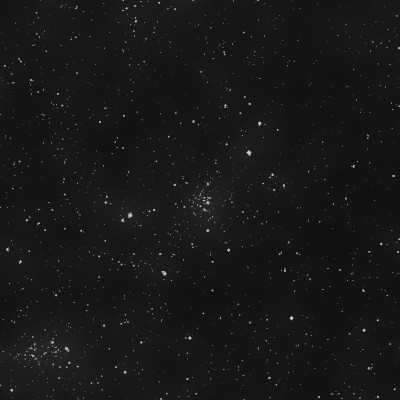
John Herschel discovered NGC 7788 = h2283 on 5 Oct 1829 and recorded a "vS and close cluster. One * 10m with a great many minute stars close to it."
300/350mm - 13.1" (9/29/84): about a dozen mag 12-14 stars over haze in a 1.5' diameter. Includes a single bright star mag 9.3 SAO 20947 on the west edge. This is a small but distinctive group in a very rich field. Situated within a string of open clusters with NGC 7790 and Harvard 21.
400/500mm - 18" (11/26/03): fairly small, 4' rich clump of roughly two dozen stars. Includes a mag 9.7 star (SAO 20947) on the west side. Several other mag 10 stars are scattered nearby but the cluster still stands out fairly well in a rich Milky Way star field. NGC 7790 is situated 16' SE.
Notes by Steve Gottlieb
NGC 103
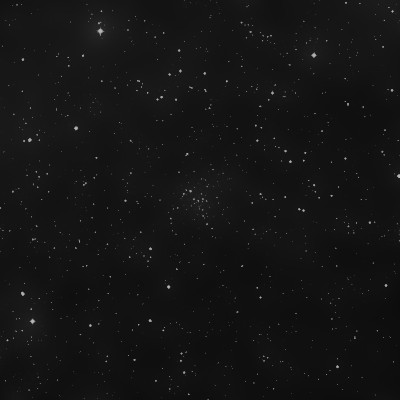
John Herschel discovered NGC 103 = h20 on 5 Oct 1829 and recorded, "pS, p compressed cl; 3' diam; st 11...18m in 2 or 3 principal branches. If this be VI 35 [NGC 136], there must be a mistake in my father's obs or mine of 6m in RA." Herschel's conjecture was wrong -[NGC 136 is a much smaller cluster, 6 minutes of RA east.
The first observation was made by William Herschel on 26 Nov 1788 (sweep 887). He noted "clustering, small stars, considerable rich", but didn't assign it a discovery number. He mentioned again, though, in his 1817 paper "Astronomical observations and experiments tending to investigate the local arrangement of the celestial bodies in space, and to determine the extent and conditions of the Milky Way."
300/350mm - 13.1" (10/20/84): 20 faint stars over unresolved haze, very elongated SSW-NNE. Two mag 11 stars are at the north end.
600/800mm - 24" (1/4/14): at 125x and 260x, ~40 stars were resolved mag 12-15, mostly within or near a distinctive 3.3' string oriented SSW-NNE. Two brighter mag 11.8/12.3 stars lie at the N end of the string, just detached from the richest clump of stars near the center of the cluster. Another sparser string of stars is parallel and just 1' W of the main string. A string of stars oriented N-S is detached to the SE of the main string. Observed with a 4 day moon up.
Notes by Steve Gottlieb
NGC 1343
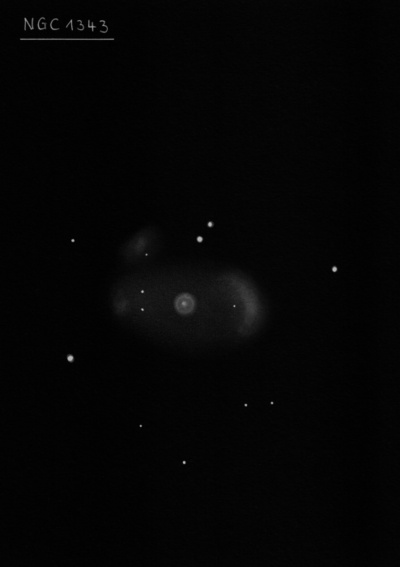
William Herschel discovered NGC 1343 = H III-694 = h300 on 11 Oct 1787 (sweep 764) and noted "vF, vS, irr R, bM. 360 confirmed it." John Herschel made two observations, recording on 29 Oct 1831 (sweep 378), "F, R, gbM, 15". Close to the double star h 2190." His position is accurate.
400/500mm - 17.5" (10/13/90): fairly faint, fairly small, large brighter core, extremely faint halo elongated 2:1 E-W. A double star (h2190 = mag 13/14 at 15" separation) is off the NNW edge 1.0' from the center.
900/1200mm - 48" (11/2/13): bright, large, elongated 2:1 ~E-W, ~2.2'x1.1', unusually sharply concentrated with a blazing, round core ~0.4' diameter, which is punctuated by a faint stellar nucleus. Two faint stars [14" separations] are superimposed within the eastern side of the halo and faint spiral arcs were visible in the outer halo. An extremely faint companion, identified in NED as HFLLZOA G134.74+13.65, was seen as a very low surface brightness patch 1.2' NE of center. A relatively wide pair of stars (h2190 = 13/14 at 15" separation) is 1' NNW of center. This is an unusual "nuclear ring" galaxy with intense starburst activity in the ring.
Notes by Steve Gottlieb
PGC 9892
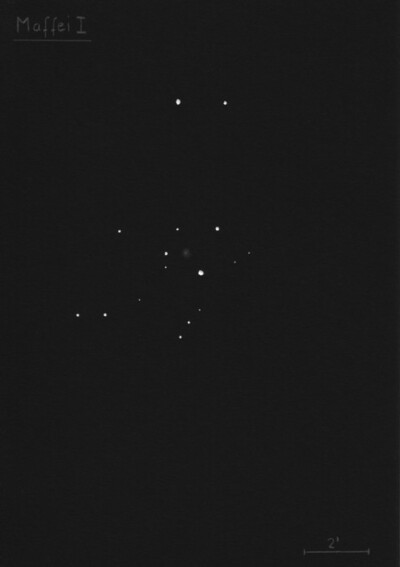
| Type | GX |
| RA | 02:36:36.5 |
| Dec | +59:38:60.0 |
| major_axis | 5.0' |
| minor_axis | 3.0' |
| mag | 11.4 |
| surface_bright | 14.1 |
Vy 1-1
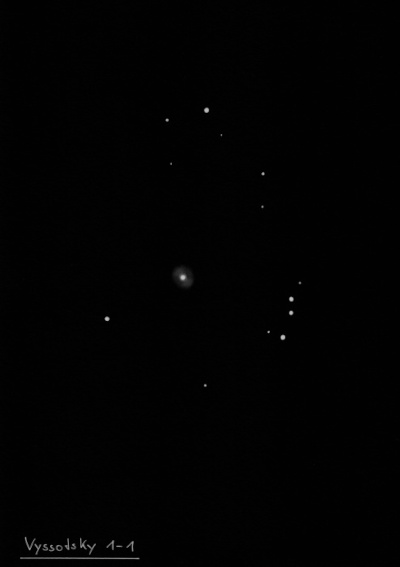
| Type | PN |
| RA | 00:18:42.2 |
| Dec | +53:52:20.0 |
| minor_axis | 48.0'' |
| mag | 12.5 |
| surface_bright | 6.8 |
Hu 1-1
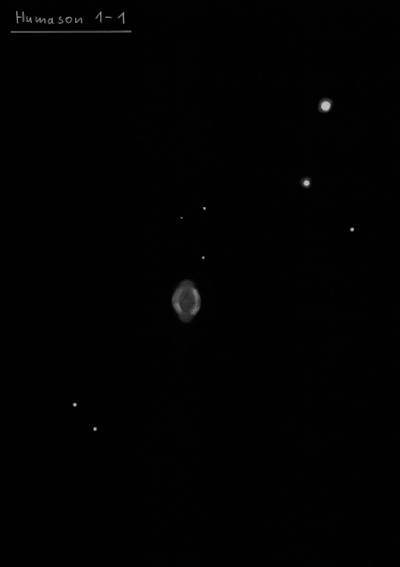
| Type | PN |
| RA | 00:28:15.4 |
| Dec | +55:57:54.0 |
| major_axis | 18.0'' |
| mag | 13.3 |
| surface_bright | 7.6 |
Abell 84
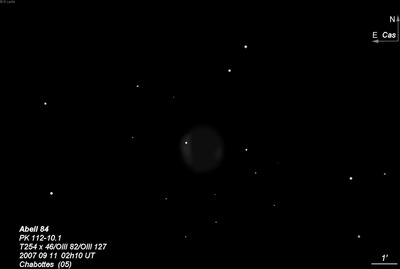
| Type | PN [3b] |
| RA | 23:47:44.1 |
| Dec | +51:23:57.0 |
| major_axis | 2.5' |
| minor_axis | 2.0' |
| mag | 14.4 |
| surface_bright | 15.9 |
BV 1
| Type | PN |
| RA | 00:20:00.5 |
| Dec | +62:59:03.0 |
| major_axis | 48.0'' |
| minor_axis | 18.0'' |
| position_angle | 3.0 |
| mag | 14.7 |
| surface_bright | 13.0 |
Abell 82
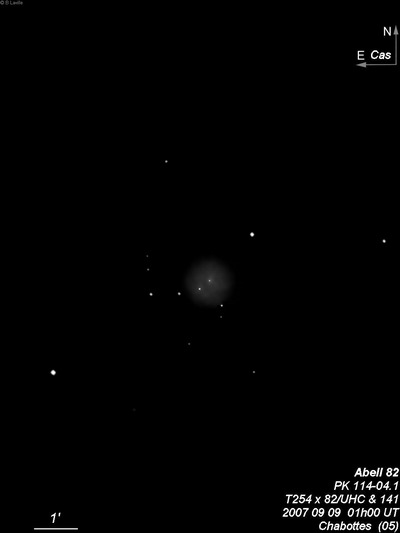
| Type | PN [3b] |
| RA | 23:45:47.8 |
| Dec | +57:03:58.0 |
| major_axis | 96.0'' |
| mag | 15.2 |
| surface_bright | 15.9 |
BV 2
| Type | PN |
| RA | 00:40:21.6 |
| Dec | +62:51:34.0 |
| major_axis | 42.0'' |
| mag | 15.4 |
| surface_bright | 14.3 |
Abell 6
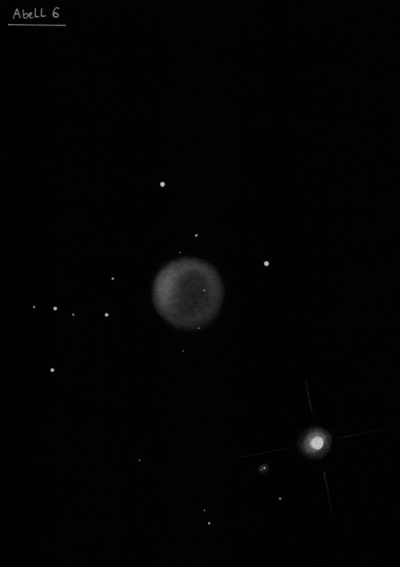
| Type | PN [2b] |
| RA | 02:58:41.9 |
| Dec | +64:30:06.0 |
| major_axis | 3.1' |
| mag | 15.5 |
| surface_bright | 17.7 |
Abell 2
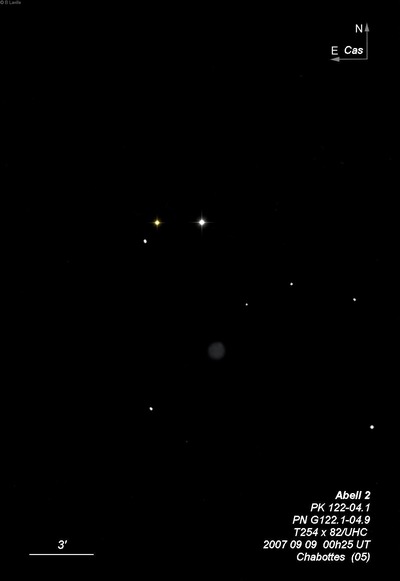
| Type | PN [2c] |
| RA | 00:45:34.7 |
| Dec | +57:57:35.0 |
| major_axis | 36.0'' |
| minor_axis | 30.0'' |
| mag | 16.3 |
| surface_bright | 14.6 |
Sh2-188
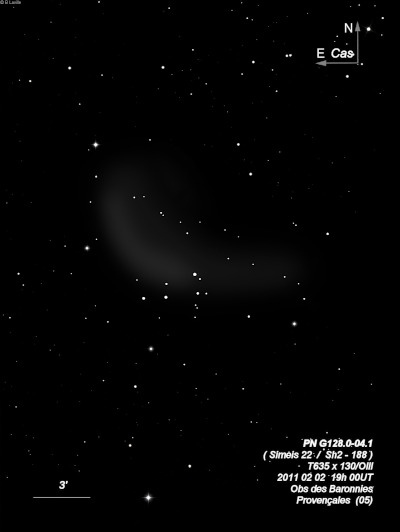
| Type | PN [E] |
| RA | 01:30:21.0 |
| Dec | +58:26:15.0 |
| major_axis | 10.0' |
| minor_axis | 3.0' |
| mag | 17.4 |
| surface_bright | 20.9 |
Abell 83
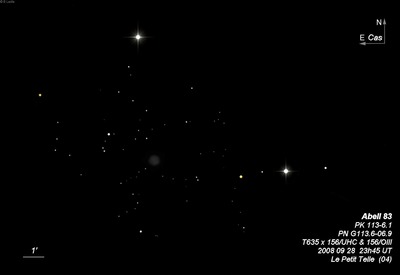
| Type | PN [2c] |
| RA | 23:46:46.7 |
| Dec | +54:44:38.0 |
| major_axis | 48.0'' |
| mag | 17.6 |
| surface_bright | 16.8 |
Abell 3
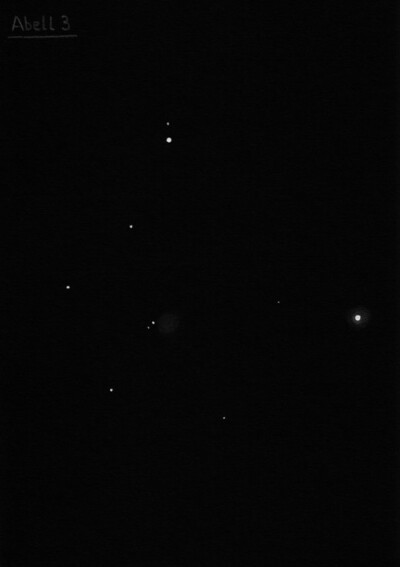
| Type | PN [3b] |
| RA | 02:12:06.7 |
| Dec | +64:09:02.0 |
| major_axis | 60.0'' |
| mag | 18.2 |
| surface_bright | 17.9 |
Abell 85
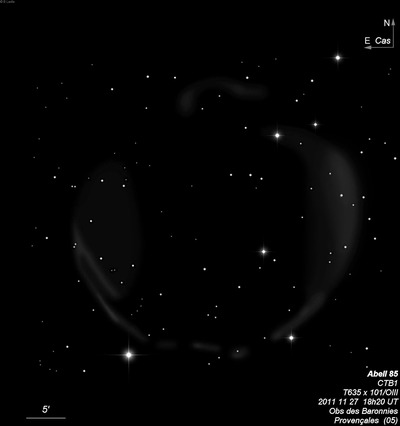
| Type | BN |
| RA | 23:58:53.5 |
| Dec | +62:30:28.0 |
| major_axis | 35.0' |
